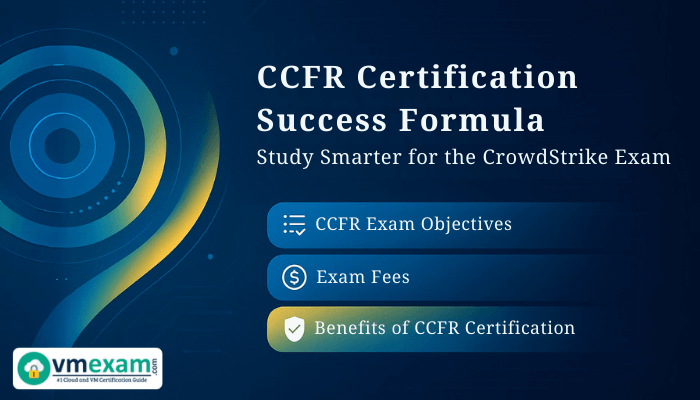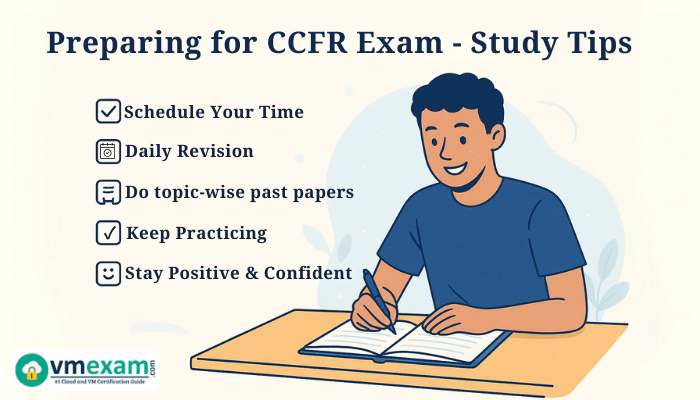
Passing the CrowdStrike Certified Falcon Responder (CCFR) exam can be a game-changer for your career in cybersecurity. As the digital threat landscape evolves, so does the demand for skilled professionals who can not only detect but also respond to threats with precision. The CCFR certification validates your expertise in leveraging the powerful CrowdStrike Falcon platform for incident response, making you an invaluable asset to any security team. But the exam is no walk in the park. With a strict 90-minute time limit and a high 80% passing score, it requires more than just a surface-level understanding.
This comprehensive guide presents a proven, five-step formula to help you study smarter, not harder, for your CCFR certification. We will move beyond simple memorization and focus on building the practical skills and deep conceptual understanding needed to ace the exam and excel in your role as a Falcon Responder. From mastering key concepts like the ATT&CK framework to practicing with realistic scenarios, we'll cover everything you need to know to secure your CCFR credential.
Why the CCFR Is a Challenging Certification
The CrowdStrike Certified Falcon Responder (CCFR) exam is an industry-recognized credential that validates a candidate's knowledge, skills, and abilities to respond to a detection within the CrowdStrike Falcon console. This is a hands-on, practical certification that tests your ability to perform initial triage, manage detections, and conduct basic investigation tasks.
What makes the CCFR exam particularly challenging?
-
Tight Timing: With 60 questions to answer in just 90 minutes, you have roughly 1.5 minutes per question. This leaves little room for hesitation or second-guessing. You must be able to recall information quickly and apply your knowledge to scenario-based questions under pressure.
-
High Passing Score: An 80% passing score means you can't afford to be weak in any of the core syllabus areas. The exam requires a strong, well-rounded understanding of every domain, from Detection Analysis to Real-Time Response (RTR).
-
Practical Focus: The questions are designed to test your operational mastery of the CrowdStrike Falcon platform. Many candidates find that simply reading documentation isn't enough; you need hands-on experience to understand the workflows and nuances of the console.
To overcome these hurdles, you need a structured and efficient study plan. The following methods are designed to build a solid foundation and give you the confidence to succeed.
Smart Study Method #1: Active Recall & Spaced Repetition
Forget passively reading a textbook. The most effective way to retain complex information for the CCFR Certification exam is through active recall and spaced repetition.
-
Active Recall: Instead of rereading your notes, actively test yourself. After learning about a topic - for example, the different types of hashes in the CrowdStrike Falcon platform - close your materials and try to explain the concept in your own words. Create flashcards for key terms, commands, and concepts. This forces your brain to retrieve information, strengthening neural pathways and making it easier to recall during the high-stakes exam.
-
Spaced Repetition: This technique involves reviewing material at increasing intervals. The idea is to review information just as you're about to forget it. Start by reviewing new concepts daily, then every few days, then weekly. This method is scientifically proven to combat the "forgetting curve" and ensure long-term retention of critical exam details. Tools and apps can help you automate this process, making it a cornerstone of your CCFR exam preparation.
Smart Study Method #2: Realistic CCFR Practice Tests
One of the most valuable resources for preparing for the CrowdStrike Certified Falcon Responder exam is a high-quality practice test. This isn't about memorizing questions and answers; it's about understanding the exam format, pacing, and the types of questions you'll encounter.
-
Simulate the Real Exam Environment: A realistic practice test should mirror the official CCFR exam's structure: 60 questions, 90-minute timer. This helps you build the necessary stamina and time-management skills. You'll learn to identify questions you know and answer them quickly, while flagging more difficult ones to revisit later.
-
Identify Knowledge Gaps: After completing a practice test, don't just look at your score. Analyze the results to pinpoint your weak areas. Did you struggle with questions on Real-Time Response? Or did the Event Investigation scenarios trip you up? This analysis will allow you to focus your study efforts where they are needed most, rather than wasting time on topics you've already mastered.
-
Boost Confidence: Going into a certification exam with the confidence that you've already experienced a similar format is a huge advantage. Taking multiple practice tests helps to reduce exam anxiety and build the mental resilience required to perform at your best.
For those looking to gain a significant edge in their preparation, a platform like VMExam.com offers a robust set of CCFR CrowdStrike questions that simulate the actual exam. These practice tests are specifically designed to help you master the key domains and build the confidence needed to pass.
Smart Study Method #3: Scenario-Based Learning with RTR
The CCFR exam heavily emphasizes practical application, especially when it comes to the Falcon Real-Time Response (RTR) module. Simply memorizing RTR commands is not enough; you must understand when and how to use them in a real-world context.
-
Go Beyond the Command Line: Focus on scenario-based learning. For instance, consider a scenario where you've identified a malicious process on a host. Your study should center on questions like:
-
What RTR command would you use to terminate the process?
-
How would you gather additional information about the process, such as its parent process or file path?
-
What are the steps to quarantine the malicious file using RTR?
-
-
Build a Mental Map of Workflows: The exam often presents you with a series of events and asks you to determine the next logical step. Practice creating mental "if-then" workflows. For example, if a detection has a specific severity level, then your first step is to check the process tree. If you see a suspicious parent-child relationship, then you pivot to the Host Timeline for a deeper investigation. This approach trains your brain to think like a professional incident responder.
Hands-on experience with the CrowdStrike Falcon platform is highly recommended. If you don't have access to a production environment, use the labs provided in the official CrowdStrike training courses or look for free trial environments to practice your skills.
Smart Study Method #4: Visual Mind Maps for ATT&CK Frameworks
The MITRE ATT&CK framework is a core component of the CCFR exam, and understanding its tactics and techniques is non-negotiable. While the framework is vast, you can make it more digestible and memorable using visual mind maps.
-
Structure Your Knowledge Visually: Instead of a long list of tactics and techniques, create a mind map with a central node for "MITRE ATT&CK." Branch out from there with the major tactics (e.g., Initial Access, Persistence, Defense Evasion, Exfiltration). Under each tactic, list the relevant techniques and provide a brief, easy-to-remember example.
-
Connect Concepts: Use lines and colors to draw connections between different techniques and the specific CrowdStrike features used to detect or prevent them. For example, a branch for "Defense Evasion" could connect to a specific "IOA Exclusion" rule or a particular Falcon feature that helps identify these techniques. This visual approach helps you see the relationships between different concepts, which is crucial for answering the complex, multi-part questions on the exam.
This method transforms a dry list of information into an interconnected network of knowledge, making it much easier to recall under pressure.
Smart Study Method #5: Peer Discussion & Knowledge Sharing
Studying in isolation can be a major disadvantage. Engaging with a community of fellow cybersecurity professionals can provide new insights and solidify your understanding of the CCFR material.
-
Join Study Groups: Participate in online forums, subreddits, or dedicated study groups for the CrowdStrike Certified Falcon Responder certification. These platforms are excellent for asking questions, sharing resources, and discussing challenging topics.
-
Explain and Teach: The Feynman Technique is a powerful learning tool. When you can explain a complex concept to someone else in simple terms, you know you've truly understood it. Take the time to explain concepts like Event Search filters or the purpose of different search tools to a study partner. Their questions might even highlight blind spots in your knowledge.
-
Benefit from Diverse Experiences: Every professional comes from a different background. A peer might share a real-world scenario from their job that perfectly illustrates a concept you've only read about in a textbook. These shared experiences can provide valuable context and make the material more memorable and relevant.
Optimizing Exam Day Strategy
Even with the best preparation, a poor exam-day strategy can derail your success. Here’s how to optimize your performance and manage the pressure.
-
Rest and Recharge: Get a full night's sleep before the exam. A tired mind struggles with focus and recall. Avoid last-minute cramming, as it often leads to burnout and increased anxiety.
-
Arrive Early and Prepared: Ensure you have all the necessary identification and check-in materials required by Pearson VUE, the platform for the CCFR Exam. Arriving early gives you time to settle in and mentally prepare without feeling rushed.
-
Time Management is Key: As soon as the exam begins, do a quick scan of the questions. Don't spend too much time on a single question. If you’re unsure, flag it and move on. Your goal is to answer all the questions you are confident about first, then return to the flagged ones with the remaining time. This ensures you maximize your score and don't get stuck on a tricky question, missing out on easier points later in the exam.
Boost Your CCFR Prep Today
Don’t waste time on scattered resources. Get realistic, high-quality practice tests and exam-ready strategies tailored for the CrowdStrike Certified Falcon Responder exam.
FAQs About CCFR Certification
Q1. How much does the CCFR Certification cost?
Ans.: The fee is $250 USD, as per CrowdStrike’s official guide.
Q2. How many questions are on the CCFR exam?
Ans.: 60 multiple-choice questions in 90 minutes.
Q3. What’s the passing score for CCFR?
Ans.: You need at least 80% to pass.
Q4. Where can I practice CCFR questions?
Ans.: You can try realistic CCFR practice tests on VMExam.com.
Conclusion
The path to CCFR Certification success isn't about brute-force memorization. It's about a strategic and intelligent approach to learning. By using active recall, spaced repetition, and realistic practice tests, you can build a strong foundation. Incorporating scenario-based learning, visual mind maps, and peer discussions will deepen your understanding and prepare you for the practical nature of the exam. The CrowdStrike Certified Falcon Responder (CCFR) credential is a powerful testament to your skills, and with the right formula, you can confidently achieve your goal and advance your career in cybersecurity.

